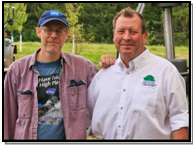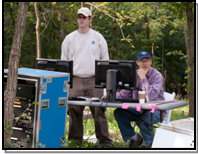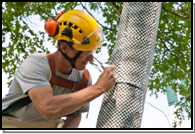Biomechanics gets a boost from NASA technology: Fall 2012
Return to Table of Contents – Fall 2012
 Any researcher can tell you that $10,000 doesn’t go far. “Seed money”, they call it. But sometimes seeds produce beanstalks of unexpected proportions. Take, for example, a $10,000 John Z. Duling research grant awarded by the TREE Fund this year to tree researchers and NASA scientists aiming to stretch the boundaries of biomechanics research.
Any researcher can tell you that $10,000 doesn’t go far. “Seed money”, they call it. But sometimes seeds produce beanstalks of unexpected proportions. Take, for example, a $10,000 John Z. Duling research grant awarded by the TREE Fund this year to tree researchers and NASA scientists aiming to stretch the boundaries of biomechanics research.
The proposal was developed by Dr. Gary Watson, Head of Research for The Morton Arboretum, and French tree biomechanics researchers Alexia Stokes and Thierry Fourcaud. The idea was the brainchild of NASA scientist Matt Melis (L) and Ohio arborist/TREE Fund Trustee Mark Hoenigman (R), hatched in conversation during a tree consult in Melis’ backyard.
“I learned from talking to Matt (Melis) that the sensors we used at our Tree Biomechanics Week in 2010 were essentially basic versions of the instruments NASA uses to measure stress on the surfaces of the space shuttle,” Hoenigman said. Melis was intrigued with the idea of applying NASA technology to tree biomechanics. A big idea was born.
The team proposed to explore how NASA’s ARAMIS digital imaging technology, developed to measure stress in the skin of the space shuttle, could be applied to tree risk assessment.

The ARAMIS method measures three-dimensional deformation and strain of components under static or dynamic loading, using stereo high-resolution video cameras and dedicated software. NASA’s equipment would be used to collect and analyze deformation data from the trunk and root plate of a tree as it moved during lateral winching tests. The objective was to adapt the technology to pinpoint potentially weak areas in trees.
The proposal met the TREE Fund’s criteria for “innovative research.” A Duling grant was awarded, and an international team of tree scientists was invited to join NASA engineers from Ohio’s Glenn Research Center for a week of ground (and tree) breaking research in September at The Morton Arboretum. As news of the project spread, arborists intrigued by its potential contributed time and resources well beyond the scope of the funding.
The research team laid claim to a stand of already-doomed ash trees at the Arboretum, stripped their bark, painted them white and stenciled an encompassing grid of small black dots on their trunks or on the soil above their roots. Using multiple cameras, they measured how each tree moved when subjected to stressors designed to simulate load.

“This is a good tool for getting the type of information we’re looking for in biomechanics,” Watson said. “The computer can track the whole surface of the tree. By measuring the movement of the dots we can chart areas of stress and pressure that indicate where a tree is likely to fail.” Next, the researchers will dig up the root systems for comparison with the images of ground movement captured during the winching tests.
Watson sees the project as a study in how “seed money” should work. “The value of the time and resources contributed to this project is probably ten times that of the original grant. We leveraged $10,000 into something much bigger.” For Melis the project represents a successful technology spinoff for NASA. “We showed an important industry how to use technology it didn’t know about, resulting in a significant jump forward in scientific knowledge.” Hoenigman’s enthusiasm for the project was summed up in a single sentence: “We’ve taken tree research to the moon!”
